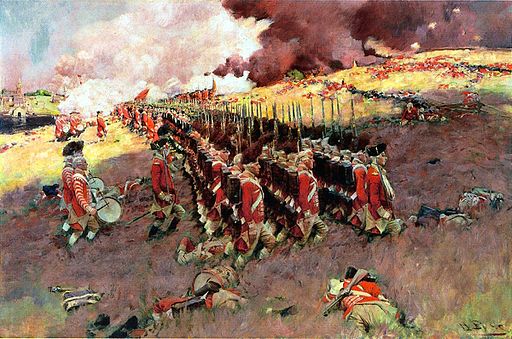The Day American and British Forces Faced Off: June 17th, 1775
On June 17th, 1775, a battle took place in Massachusetts between the American Continental Army and British forces. Colonel William Prescott commanded the Patriots during this engagement, with support from Groton soldiers. Sources indicate that John Gage, a British officer, sent a letter to Prescott before the battle began, offering him an opportunity to surrender. However, Prescott refused to back down and led his company into battle near Boston.
The state of affairs was tense at the time; tensions had been brewing for weeks between the colonial troops and the British army. As part of his command, Prescott ordered his continental army men to construct defensive works on Bunker Hill and Breed’s Hill near Boston Harbor, in preparation for a possible British attack. When word reached General Thomas Gage that these works were being built by the patriots, he ordered his soldiers to take action.
As shots rang out across the rail fence separating the two sides on June 17th, it marked an important moment in history as it was one of the first major engagements between American patriots and British troops during the Revolutionary War. Despite being outnumbered and outgunned by their opponents’ artillery, Groton soldiers under Prescott’s leadership helped inspire courage among his troops as they fought for their independence. Today, the Bunker Hill Monument stands as a tribute to their bravery.
We’ll also examine different perspectives from both sides involved in this pivotal moment in American history, while looking at some of the key factors that contributed to this historic event. Americans will find sources of engagement during this time.
Background of Colonel William Prescott
Who was Colonel William Prescott?
Colonel William Prescott, a farmer and soldier, played a significant role in the American Revolutionary War. He was born on February 20, 1726, in Groton, Massachusetts, and held a colonial position before the war. Prescott led the Americans in the Battle of Bunker Hill against British soldiers in Charlestown.
Military Career of Colonel William Prescott
Prescott’s military career began during the French and Indian War when he served as a captain in Roger’s Rangers, a colonial unit of British soldiers. He later fought in the Battle of Louisburg and the Battle of Quebec. Afterward, he returned to his farm until he was appointed as a colonel of the 7th Middlesex Regiment of the Massachusetts militia in 1775. During the American Revolution, he was tasked with leading the construction of a redoubt on Breed’s Hill in Charlestown.
The Role of Colonel William Prescott in the Battle of Bunker Hill
Along with Israel Putnam, Colonel Prescott played a crucial role in the Battle of Bunker Hill on June 17, 1775 in Charlestown, Boston. During this colonial battle, British troops launched an attack on Breed’s Hill where American soldiers were stationed in a redoubt. Despite being outnumbered and outgunned by British forces, Colonels Putnam and Prescott led their men to defend their position fiercely.
One famous quote attributed to Colonel William Prescott during the Battle of Bunker Hill is “Don’t fire until you see the whites of their eyes.” This command meant that soldiers should not waste artillery ammunition by firing too early but rather wait until they could see their targets clearly. The redoubt was a key position in the defense of Charlestown against the attack.
Despite eventually losing control over Breed’s Hill in Charlestown due to lack of ammunition and reinforcements, Colonial Colonels Putnam and Prescott’s leadership inspired American troops throughout the war with their strategic use of artillery and construction of a redoubt.
Legacy of Colonel William Prescott
Colonel William Prescott, a colonial hero, is remembered for his bravery and leadership during some significant battles in Charlestown and Boston during America’s fight for independence. In honor of his contributions to history, there are several memorials dedicated to him across Massachusetts, including one alongside General Putnam.
One notable memorial is located on the Charlestown peninsula at Bunker Hill Monument National Park. This colonial-era monument stands tall at 221 feet and is the tallest structure in Boston. It was built to commemorate the Battle of Bunker Hill, where Colonel Prescott played a crucial role in defending the redoubt against General Howe’s troops.
Another colonial memorial dedicated to Colonel Prescott is located in his hometown of Groton, Massachusetts. This statue depicts him standing tall with a sword by his side. Additionally, he played a significant role in the Battle of Bunker Hill, fought in Charlestown, Boston alongside General Putnam.
Fortification of Breed’s Hill
On June 17th, 1775, Colonel William Prescott led the colonial forces in the fortification of Breed’s Hill, a strategic move to protect the Charlestown Peninsula and Boston Harbor from the British Army led by General Howe during the Revolutionary War. The colonists built a redoubt on top of Breed’s Hill and reinforced it with a rail fence to defend against the British assault and attack. Despite being outnumbered, the colonial fire was fierce and the Groton soldiers held their ground until they ran out of ammunition.
Building Fortifications
The decision to fortify Breed’s Hill in Charlestown was made by Colonial Colonel William Prescott after he realized that Bunker Hill on the peninsula would be too difficult to defend due to its open terrain. He chose Breed’s Hill because it was closer to Boston Harbor and easier to fortify with a redoubt. The colonial colonists began building their defenses on June 16th, under cover of darkness.
They constructed a redoubt on the Charlestown peninsula using dirt and hay bales as a base for protection against enemy fire during the attack on Boston. They also reinforced it with a rail fence which provided additional cover from musket balls fired by British troops. The fence was made up of wooden rails that were stacked horizontally on top of each other.
Battle Commences
On June 17th, 1775, British General Thomas Gage ordered his troops to attack the colonial forces at Breed’s Hill in Charlestown. The British plan was to take control of both hills (Breed’s Hill and Bunker Hill) in Boston and force the colonists out of their positions in the redoubt. General William Howe led the attack.
The first wave of British soldiers launched their attack on the redoubt near Charlestown, but were met with heavy resistance from the colonial forces who had taken up positions behind their fortifications. Despite suffering heavy casualties, including many officers killed or wounded, they managed to reach the top of the hill where they engaged in hand-to-hand combat with the colonists under the command of General Howe.
Running Out of Ammunition
The colonial fire was fierce, and the Groton soldiers held their ground at the redoubt in Charlestown until they ran out of ammunition. At this point, Colonel William Prescott ordered his troops to retreat from Breed’s Hill towards Boston. The British forces under General Howe had suffered heavy casualties during the battle, losing over a thousand men compared to only four hundred for the colonists.
Aftermath
Although the British technically won the Battle of Bunker Hill (as it was commonly known) in Charlestown near Boston, General Howe suffered heavy losses and failed to capture the colonists’ redoubt. The battle was a significant morale booster for the colonial forces who realized that they could hold their own against one of the most powerful armies in the world.
Today, visitors can visit Breed’s Hill in Charlestown, Boston and see where the colonial fortifications were built. There is also a monument on Bunker Hill which commemorates this important event in American history, led by General Howe.
Battle Strategy
On June 17th, 1775, Colonel William Prescott led the colonial defense against British attacks on Bunker Hill in Charlestown, near Boston. Despite their eventual retreat, the colonists’ successful defense and heavy casualties inflicted on the British forces under General Howe make this battle a significant moment in American history. Let’s take a closer look at Colonel Prescott’s battle strategy and how it played out on that fateful day.
Building Fortifications
Colonel Prescott’s primary colonial strategy in Boston was to build a fortification atop Bunker Hill to defend against any Howe’s British attacks. The fortification was constructed using dirt from nearby trenches, creating a wall-like structure around the perimeter of the hill. This strategy allowed the colonial men to have an elevated position from which they could fire upon British troops below.
Flanking Attacks and Artillery
As the British forces advanced towards Boston, they were met with flanking attacks from both sides by colonial troops led by Howe. These skillful maneuvers slowed down the British advance and gave the colonists more time to fire upon them from above, causing heavy casualties among British men. Artillery pieces were used by the colonists to inflict even more damage on approaching British troops.
Three Assaults
The first two assaults by British forces in colonial Boston were unsuccessful due to Colonel Prescott’s tactics and his men’s determination in defending their position. However, during the third assault, the colonial fighters ran out of ammunition and were ultimately forced to retreat.
Maps Used for Planning
Both colonial sides utilized maps of the Boston battlefield when planning their respective strategies for attack and defense. For example, General Thomas Gage used maps when strategizing his initial attack plan against Bunker Hill, while General Howe directed his men using the same maps during the Battle of Boston.
Heavy Casualties
Despite their eventual victory, British troops suffered heavy casualties during their three assaults on Bunker Hill in colonial Boston due to Colonel Prescott’s successful defense tactics. Approximately 1/3 of all British men who participated in this battle under the leadership of General Howe were either killed or wounded.
The Importance of Sight in Battle
The Eyes: A Soldier’s Primary Source of Information
Sight is crucial for colonial men. In fact, the eyes are a soldier’s primary source of information, allowing them to assess their surroundings and make quick decisions that can mean the difference between life and death. Without good vision, soldiers would be unable to navigate through terrain or identify potential threats.
Good Vision: A Matter of Life and Death
In June 17th, 1775, Colonial Colonel William Prescott led his troops into battle at Bunker Hill. They were outnumbered by the British forces and had limited resources. However, what they lacked in numbers and equipment they made up for with their exceptional marksmanship skills. One of the reasons for this was due to their keen sense of sight.
Good vision can mean the difference between life and death on the colonial battlefield. Soldiers with excellent eyesight are better able to spot enemy movements from a distance and take action quickly. This can give them a significant advantage over their opponents in colonial times.
Poor Visibility: A Hindrance to Effective Fighting
On the other hand, poor visibility can hinder a colonial soldier’s ability to fight effectively. Dusty or smoky environments can cause eye irritation or even temporary blindness, making it difficult for colonial soldiers to aim their weapons accurately or see incoming attacks.
To combat this issue, colonial soldiers must protect their eyes at all times by wearing goggles or protective eyewear that shields them from debris while still allowing men full range of vision.
Protecting Your Eyes: Essential for Maintaining Sight
Protecting your eyes is essential for men in colonial times if you want to maintain your sight throughout your military career. This means taking care not only during combat but also during training exercises where debris or flying objects could pose a risk.
Men, including colonial soldiers, should also undergo regular eye exams to ensure that any issues are caught early on before they become more serious problems that could impact their performance on the battlefield.
Result and Aftermath
Pyrrhic Victory for the British
The colonial Battle of Bunker Hill took place on June 17th, 1775, in Charlestown, Massachusetts. The battle was fought between the British Army and American forces during the early stages of the American Revolutionary War. Despite suffering heavy casualties, the colonial men managed to inflict significant damage on the British army. The battle resulted in a Pyrrhic victory for the British since they won but at an enormous cost.
The colonial British suffered over 1,000 casualties, mostly men, while only managing to kill or wound around 400 American soldiers. This high number of losses significantly impacted their morale and resources. The victory was seen as a hollow one since it came at such a steep price.
Boosted Morale for American Forces
Despite suffering heavy losses, the outcome of the colonial battle boosted morale among American forces. They had just fought against one of the most powerful military forces in history, proving that they could win battles against superior colonial armies and that they were not fighting a lost cause.
The colonial morale boost also helped with recruitment efforts as more colonial people joined the fight after hearing about their success at Bunker Hill. It was a turning point in terms of public perception as many colonial people began to believe that America could win this war.
Reassessing Strategies for Both Sides
The aftermath of Bunker Hill saw both sides reassessing their strategies for future battles. The British realized that they needed to change tactics if they wanted to defeat America quickly. They started focusing on capturing strategic locations instead of engaging in direct combat with American forces.
On the other hand, American leaders recognized that they needed better training and discipline if they were going to win this war. They used Bunker Hill as an example of how bravery alone would not be enough to secure victory; tactical planning was crucial too.
Letter from William Prescott to John Adams
On June 17th, 1775, the Battle of Bunker Hill took place in Massachusetts towns. Colonel William Prescott played a significant role in this battle and wrote a letter to John Adams about the events that occurred during that day. This letter provides valuable insights into the battle and its aftermath.
The Letter’s Contents
General Prescott’s letter is an essential historical document that sheds light on what happened during the Battle of Bunker Hill. In his letter, he describes how he led his troops and gives accounts of other notable figures’ actions, such as John Stark and Israel Putnam.
One of the most significant moments in the battle was when Joseph Warren was killed. General Prescott mentions this tragic event in his letter, highlighting Warren’s bravery and sacrifice for the Patriots’ cause.
The British officers also feature prominently in General Prescott’s letter. He writes about General Clinton and Major John Pitcairn, two prominent figures who played critical roles in the British army at that time.
Significance of the Letter
General Prescott’s letter is an important historical document because it provides an eyewitness account of one of America’s most significant battles. The information contained within it has helped historians gain a better understanding of what happened during the Battle of Bunker Hill.
Moreover, General Prescott’s account shows how much courage and determination were required to fight against such a formidable foe as the British army. His words serve as a reminder of how far Americans have come since those early days when they fought for their independence.
Conclusion
In conclusion, Colonel William Prescott played a crucial role in the Battle of Bunker Hill on June 17th, 1775. He was a skilled leader who had experience in battle and was able to fortify Breed’s Hill effectively. His battle strategy proved successful despite the eventual loss of the hill to British troops.
One key takeaway from this battle is the importance of sight in warfare. The ability to see and accurately shoot at your enemy can make all the difference in a battle’s outcome. This lesson has been applied throughout history and is still relevant today.
Furthermore, William Prescott’s letter to John Adams provides insight into his thoughts and feelings during the battle. It gives us a glimpse into the mind of a leader facing an intense situation.
Overall, Colonel William Prescott’s leadership and strategic decisions were instrumental in the Battle of Bunker Hill. His actions continue to inspire leaders today to be brave, decisive, and resourceful.
FAQs
Q: What was Colonel William Prescott known for?
A: Colonel William Prescott was known for his military leadership during the American Revolutionary War. He played an important role in several battles, including the Battle of Bunker Hill.
Q: How did Colonel William Prescott fortify Breed’s Hill?
A: Colonel William Prescott ordered his men to construct earthworks on top of Breed’s Hill using whatever materials they could find nearby. They used fence posts, hay bales, and other debris as makeshift barriers.
Q: Did Colonel William Prescott win the Battle of Bunker Hill?
A: No, although he fought valiantly with his men, they eventually lost control of Breed’s Hill to British troops due to lack of ammunition.
Q: Why is sight important in warfare?
A: Sight is important because it allows soldiers to locate their enemies accurately and shoot at them more effectively. In modern times, technology has advanced this aspect further with night vision goggles and other tools.
Q: What can we learn from Colonel William Prescott’s leadership?
A: We can learn that bravery, decisiveness, and resourcefulness are essential qualities for leaders in times of crisis. Colonel Prescott’s actions continue to inspire leaders today.



